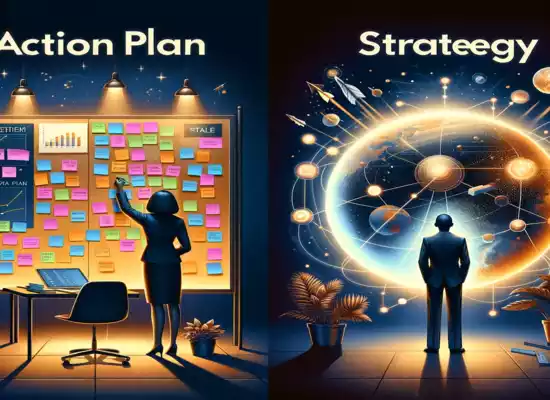Action Plan and Strategy are structured approaches to achieving desired outcomes. An action plan lays out in detail all of the actions and steps needed to reach a given goal or objective, breaking it into smaller, manageable tasks with deadlines set and resources allocated accordingly.
An organization’s strategy is a long-term plan that defines its approach to reaching its goals and objectives. A strategy requires an assessment of current conditions, and identification of strengths and weaknesses within an organization.
As well as potential threats and opportunities, setting priorities accordingly, and selecting an approach with long-term success in mind. A good strategy serves as a guideline for resource allocation decisions over an extended period.
What Is an Action Plan?
A plan of action is a thorough step-by-step procedure designed to accomplish specific objectives. It defines what is required to be completed, who’s accountable for each task and the time frame for its completion. Action plans can be used in a variety of contexts, from projects for business to personal goals. They begin with clearly defined objectives and then break down the way to accomplish them into small tasks.

Each task is delegated to individuals or teams and is accompanied by clear deadlines and the resources required. This approach aids in organizing resources and efforts efficiently, as well as ensuring accountability and monitoring the progress.
Action plans are flexible and can be altered depending on the changing circumstances. They function as a guideline to help teams and individuals remain focused and in line with their objectives. By breaking down big objectives into smaller, achievable actions, action plans achieve goals more achievable and less daunting.
What Is Strategy?
A strategy is a thorough program or set of rules created to reach the long-term objectives or goals. It’s a plan that guides choices and actions, generally in uncertain, complex environments. In the business world strategy focuses on determining the direction of a business in making decisions on the best way to allocate resources, and also establishing an effective competitive position.

It is about knowing the business environment such as trends in the marketplace as well as competition and external strengths as well as weaknesses.
The strategic approach requires wide perspective, with a focus on the long-term and not tactical strategies that are short-term in nature. It is often about setting priorities, focusing on your important strengths, analyzing the market’s competitive landscape, and anticipating possible changes on the market. A well-constructed strategy can assess possible risks and incorporate contingency plans.
In a broad perspective, strategy could be applied to any field in which planning for the long term is essential in such areas as military operations elections, and even personal and professional growth. It’s about setting goals clearly and understanding how to accomplish them, and being able to adapt to changes. A successful strategy doesn’t just outline the goals to be met but also explains the reasons why certain routes are preferred over others, and provides an organized framework for decision-making.
Key Difference Between Action Plan and Strategy
Here’s a comparison chart highlighting the main differences between an Action Plan and a Strategy:
| Feature | Action Plan | Strategy |
|---|---|---|
| Purpose | A detailed plan outlining specific tasks and steps to achieve short-term objectives or goals. | A high-level approach to achieve long-term objectives or goals. |
| Scope | Focuses on specific activities, resources, timelines, and responsibilities. | Encompasses a broader vision and direction for the organization or project. |
| Timeframe | Short-term, typically covering days, weeks, or months. | Long-term, often spanning several years. |
| Implementation | Provides a roadmap for executing tasks and activities. | Offers a framework for decision-making and resource allocation. |
| Flexibility | May have less flexibility as it deals with immediate actions. | Allows for adaptability and adjustment to changing circumstances. |
| Alignment | Derived from the strategy of an organization or project. | Driven by the organization’s mission, vision, and objectives. |
| Level of Detail | Contains specific, measurable, achievable, relevant, and time-bound (SMART) objectives. | Focuses on the broader direction without detailed actions. |
| Stakeholders | Primarily used by teams and individuals directly involved in execution. | Utilized by leaders and decision-makers to guide the organization’s direction. |
| Examples | – An action plan for launching a marketing campaign. | – A strategy to expand market presence and increase market share. |
Balancing Strategy and Action
The balance between strategy and action is essential to the success of any company or project. Strategies provide the underlying strategy and orientation, establishing long-term goals, and defining the method to reach them. It requires understanding the larger environment, including trends in the market and competitive landscape as well as internal capabilities.
Without the ability to act, the strategy remains only a thought-provoking exercise. The process of implementing the strategy involves executing the plan by taking concrete actions. This involves translating the strategy plan into daily plans and actions.
The trick to balance both of these aspects is flexibility and alignment. The first thing to remember is that the actions you take must be aligned with the strategic goals. Every project, initiative, or job should contribute to the strategic objectives.
This ensures that resources are utilized efficiently and that efforts are not wasted on activities that are not productive. Additionally, both strategy as well as actions must be able to change. The business world is ever-changing and so both the strategic plan as well as its execution must be able enough to adjust to changes in the business environment.
A clear and effective communication process between strategists as well as the ones who are responsible for execution is crucial. Regularly reviewing and updating strategies and action plans ensure that they are relevant and operate together. When they achieve this balance organisations can not just visualize success, but also pursue it in a cohesive and coordinated way.
How can an effective action plan and strategy be developed?
- Locating Opportunities or Problems: Determine which opportunities or problems need to be tackled these could range from challenges, goals or objectives that must be accomplished to those that must be achieved in terms of time or costs.
- Analysis and Research: Gather information, data, and insight regarding your problem or opportunity before conducting in-depth analyses that reveal key determinants that affect its success or failure.
- Goal Setting and Targets: Based on your analysis, set specific, measurable, attainable, relevant, and timely goals that align with the vision and mission statements for your organization.
- Establish a Timeline and Action Steps: Break goals and objectives down into individual steps that need to be completed, assign deadlines and assign responsibilities, then develop a timeline outlining these processes and their order of occurrence.
- Monitor and Evaluate Progress: Regularly assess progress toward your goals and objectives using metrics or key performance indicator (KPI) measurements look out for areas for improvements and pinpoint them using KPIs or similar measurements.
- Change or Update As Needed: Your plan or strategy may need to adapt to changing conditions or enhance its efficacy be prepared for goals, objectives, and actions to change as necessary.
An effective action plan or strategy requires sound planning that is both well-structured and feasible, yet adaptable to changes in circumstances.
Action Plans and Strategies Examples in Different Contexts
Here are a few examples of action plans and strategies that may be utilized across various contexts:
Business: Companies can devise an action plan to launch new products. This may involve conducting market research and creating an advertising campaign designing and testing their new product before setting its release date and release.
An organization may develop a marketing strategy with the intent of increasing market share, with goals like expanding into new markets or creating innovative new products as goals, improving customer service or raising brand recognition as goals.
Education: A teacher can devise an action plan to enhance student performance, such as creating lesson plans and assessments, providing individual instructions or monitoring student progress.
School districts can develop plans designed to enhance student performance. Such strategies might involve improving teacher training, increasing parent involvement, implementing new technology into classrooms, and renovating school facilities.
An individual can develop an Action Plan to enhance their health and well being, with tasks such as setting fitness goals and creating a nutrition program, as well as scheduling regular checkups and finding ways to deal with stress management.
Healthcare organizations can develop strategic plans designed to improve patient outcomes. Such plans might focus on goals such as implementing new technology or treatment protocols increasing patient engagement/education programs or better experience for all involved patients.
Government: Cities can develop an action plan to tackle specific issues such as crime reduction. Such plans might involve tasks like increasing police patrols in high crime zones and upgrading lighting as well as working with local organizations on root-cause investigations.
State governments can devise strategies designed to attract new businesses and generate jobs in their state, such as lowering taxes and regulations, investing in infrastructure upgrades and investing in education/program training for its people, or simply creating an inviting work environment for startups and established firms alike.
Action plans and strategy play an essential role in reaching goals and objectives, whether for organizations or individuals alike. By breaking goals down into more manageable steps and devising plans to reach them, chances of success increase significantly.
Summary
An action plan and strategy are both key tools in reaching goals in diverse contexts such as business, education and health, government or otherwise. An action plan lays out specific steps and tasks required for reaching one or more of your goals on the other hand, strategy provides direction.
Researching, analyzing, and setting goals that can be measured tangibly are all vital steps toward creating an action plan with timelines, assigned responsibilities and monitoring progress regularly while being flexible enough to adapt when adjustments may need to be made along the way. Individuals or organizations who create well-structured action plans increase their odds of success.

